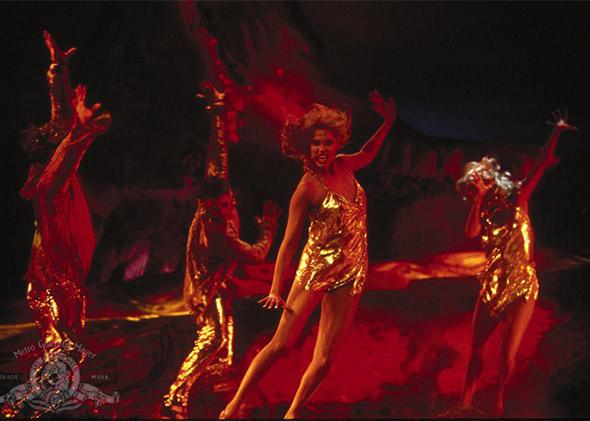Pauline Kael wrote “Trash, Art and the Movies” in 1969, when trashy movies needed a boost via a pioneering critic and a glossy magazine. Today, the merits of a gleefully tacky movie hardly need to be defended. If you want proof that bad movies have their own particular value system, visit a packed midnight screening of The Room. But It Doesn’t Suck, Adam Nayman’s critical re-evaluation of Paul Verhoeven’s 1995 film Showgirls, doesn’t go the “so bad it’s good” route. Nayman, a Toronto film critic, won’t let the movie off the hook that easily. He advocates for a view of Showgirls as intentional and premeditated—maybe even art.
Kael wanted viewers to enjoy trashy movies, but not to take them too seriously; It Doesn’t Suck—which takes its title from the lead character’s favorite phrase—argues that Showgirls hasn’t been taken seriously enough. Nayman brushes off Showgirls to reveal a diamond sparkling underneath the layers of critical sludge. In doing so, he heroically liberates it from the junk heap of movies deemed enjoyable only so long as we acknowledge that they’re pieces of crap.
For the uninitiated, Showgirls tells the story of Nomi Malone (Elizabeth Berkley), who in the opening scene thumbs a ride to Las Vegas with dreams of making it as a dancer. After a stint at a strip club, she earns a spot in the chorus of Goddess, a topless dance show. The star of Goddess, Cristal Connors (Gina Gershon), quickly becomes Nomi’s nemesis, even as the two share the kind of flirty homoerotic banter that only a man could conjure up. Nomi does rise to the top, but she learns, of course, that success comes at a high price.
Showgirls is an erotic thriller, a showbiz parable, and a parody of the movie musical, all at once. In short, it’s a hot mess. It’s also endlessly fascinating in ways that Nayman nimbly teases out. He’s particularly attuned to the movie’s many instances of doubling, noting, “Showgirls as a whole is filled with mirrors.” Take the movie’s infamous lunch scene, midway through the film, in which the women discuss their mutual admiration for dog food, and Cristal compliments Nomi on her rack. (“I like having nice tits,” Nomi earnestly replies.)

Courtesy of ECW Press
The scene may be emblematic of what some critics have called out as cringe-inducing screenwriting. But there’s much more going on here from a filmmaking perspective. As Nayman observes, in this scene, Verhoeven violates the “180-degree rule”—a basic filmmaking principle that dictates that the camera must stay on one side of the object being filmed. If you’re shooting a conversation between two characters who are facing each other, like in the restaurant scene, one character should always remain on the right side of the frame while the other stays on the left; the camera should not cross over an imaginary line drawn between the two characters.
Halfway through the lunch scene, however, Verhoeven “crosses the line”: Where before Nomi always appeared on the right side of the frame, now she’s on the left. The technique, Nayman argues, hints that Nomi and Cristal—whose name is significant, “crystal being a surface that reflects”—are mirror images of each other, and provides a sneaky bit of filmic irony to Nomi’s insistence that she’s nothing like Cristal. “I’ll never be like you,” she tells her rival, even as she mimics Cristal’s earlier gesture by flicking a bit of Champagne—Cristal, of course—in her face. “Good filmmaking propping up bad screenwriting; a bad actress dragging down a good one,” Nayman writes. “It’s all in plain view.”
So the film is, in some ways, savvier than it lets on. But to what effect? Showgirls, Nayman offers, “is a movie that is also a mirror, one that offers a vivid rearview on a very particular pop-cultural moment and also a telling reflection of the viewer.” Like the whore Nomi once was, Showgirls can be anything you want it to be. That’s partly what makes it such a frequent and rich subject for critical discussion. There’s just so much there: Manically over-the-top dancing, topless manically over-the-top dancing, judicious dry humping, boobs, boobs, and more boobs, the insane amount of makeup Elizabeth Berkley wears, her overzealous performance. And also: artful and subversive filmmaking, A-plus production and costume design, an intense emotional pitch, Gina Gershon’s arch and knowing performance.
The critical consensus is that Showgirls took itself too seriously. In the crack between the Vegas horror story it wants to be and the Day-Glo guilty pleasure it became, any artistic integrity Showgirls tried to claim went splat. But Nayman, ever valiant, comes to the film’s rescue. Quentin Tarantino’s “entire post-Jackie Brown output, with its obsessive focus on ice-cold revenge, is deeply indebted to the final act of Showgirls,” he asserts, pointing to a scene late in Showgirls where Nomi avenges the rape of a friend—first pretending to seduce the rapist, then beating him senseless.
View the scene as an allegory for the audience’s experience of Showgirls. We were promised a no-holds-barred erotic thrill ride, but wind up assaulted by the film’s cavalcade of bad writing, worse acting, and the blunt violence of the friend’s rape, which feels out of place in a movie that gestures toward explicit sex but stages its lone sex scene like a dance. As Roger Ebert wrote in his review of the film, “Showgirls is such a waste of a perfectly good NC-17 rating.”
Then again, maybe the fact that Showgirls lies somewhere between a torrid sex fest and a landfill of bad taste is entirely appropriate. In response to the New York Times’ Janet Maslin’s complaint that Joe Eszterhas’ screenplay prevents “any character from entertaining two consecutive thoughts in a given scene,” Nayman slyly replies, “Why settle for two consecutive thoughts when you can be of two minds at the same time?”
Finally, the verdict is simple: “It doesn’t suck.” Showgirls is not a piece of shit or a masterpiece—it’s a “Masterpiece of Shit,” Nayman writes, and the book’s embrace of both of Showgirls’ “two minds” is its greatest strength. It Doesn’t Suck frees viewers from the constraints of the guilty pleasure—because if you feel guilty watching Showgirls, you’re doing it wrong. As Kael wrote, “Movies—a tawdry corrupt art for a tawdry corrupt world—fit the way we feel.”
Showgirls may have initially been dismissed, but when I rewatched it for this review—twice, of course, in keeping with its doubling motif—I was surprised at how it made me feel: not angry or amused or dismissive, but sick to my stomach. Not because it’s a terrible movie, but because it’s such an effective one. Nomi’s full-circle journey from nameless drifter to star and back again really is horrific, filled with backstabbing rivals, conniving love interests, and brutal rapists. In its 128 minutes, it seems to encompass all the sleaze in Las Vegas and then some. And more importantly, you can’t take your eyes off it. It Doesn’t Suck isn’t just a book about Showgirls, but about the way we perceive such films and how that perception changes over time. As an extended conversation on one of the most ridiculed films of the past two decades, Nayman’s book is a valuable gift. After all, the only thing more fun than watching a deliciously tacky movie is picking it apart with your friends when the lights go up.
—
It Doesn’t Suck by Adam Nayman. ECW Press.
See all the pieces in this month’s Slate Book Review.
Sign up for the Slate Book Review monthly newsletter.
